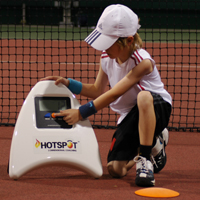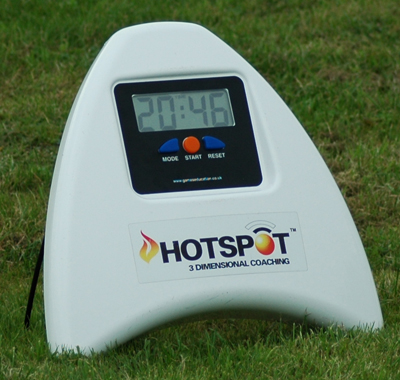- February 02nd, 2011
- Coaching/Training, General, Uncategorized
- admin
Hi all a little piece about the merits and values of straight line sprints in assessment. This was stimulated by a discussion I had with the head of fitness at a Premiership football club yesterday….
So in a number of sports a straight line sprint features in many assessments for talent identification, fitness and general baseline measurements. It is standard in the LTA and used in many football clubs. But here’s some conundrums for you :
1. Is it relevant to the sport / game play?
2. Does it have positive predictive value for athletic success in that sport?
3. Is there a better test that might address points 1 & 2?
Firstly we need to look at point 1. The straight line sprint is used as we have mentioned in both tennis and football in a talent identification setting. But I wonder how often in these games do athletes ever run a long distance in one go? Very seldom I would suggest. Both sports actually have much shorter sprints within the game and the movement is rarely isolated to one direction.
In terms of predicting success then clearly the test needs to replicate some kind of functional movement within the game. What straight line sprint shows is how quick an athlete is over a certain distance. No-one can dispute that and the ease and simplicity of the test. But what we are testing is acceleration but missing the very crucial element of deceleration – what use is it if in running so fast the athlete cannot then decelerate and change direction? He may be quick across the tennis baseline but if the point isn’t won on that shot then without good deceleration skills he will be hopelessly out of position for the next shot. In football that sprint back to regain position as a defender is pointless if as a result he cannot slow and change direction, the attacking forward merely has to cut inside and the defender is now beaten and too far out of position to regain the ball.
So how might we better assess movement skills that are game specific?
I decided when I started coaching my Under 10s in July 2010 I would look at 4 areas of fitness, agility and movement skills in the players and see which (if any!) could address the points above. The four tests were :
1. 80m straight line sprint
2. Illinois Agility Test
3. HotSpot 4 square agility test ©
4. Bleep test
The HotSpot 4 square agility test is a simple figure of eight with 8 changes of direction around a 2.5m square testing precision, acceleration and deceleration movement skills. The points are marked by HotSpot discs so there is drill precision and every test is identical with reliable timing by the system.
I benchmarked each player and collated the data with a view to regular interval tests to see any changes – hopefully for the better! The training sessions each week have a heavy emphasis on movement training, agility and fitness with this comprises around 50% of the time.
I have summarised the data below comparing the 80m sprint with HS 4 Square Agility Test. The athletes are scored according to their position in the group for each of the tests and the difference shown in the far column. An improvement in rank from 80m to HotSpot Agility is showed as a + with rank position change and a – for a drop in their rank :
| Athlete | 80m Sprint Rank | HS 4 Square Rank | Change in Rank |
| A | 10 | 8 | +2 |
| B | 5 | 5 | 0 |
| C | 11 | 7 | +2 |
| D | 9 | 11 | -2 |
| E | 3 | 1 | +2 |
| F | 8 | 3 | +5 |
| G | 2 | 6 | -4 |
| H | 4 | 2 | +2 |
| I | 6 | 4 | +2 |
| J | 12 | 12 | 0 |
| K | 7 | 9 | -2 |
| L | 1 | 10 | -9 |
So what does all this data mean?! Look at the end column and see the change in rank between the two tests. If we take that moving in an agile fashion and moving quickly are not only equally important but comparable then there would be very little discrepancy between the two activities ie if you were fast in a straight line then you will also be fast round an agility circuit. This would be reflected in a small change if any in the rank difference.
Well this is clearly not the case. Only 1 athlete of the top 4 in the 80m sprint is in the top 4 for the 4 square HotSpot agility test. And only 2 of the bottom 4 ranked in the sprint are in the bottom 4 in the agility test.
If as we have suggested then the ability to move with agility and to be able to change direction is actually more relevant to the sport, then this data suggests the 80m sprint test has poor positive predictive value for the attributes necessary for the sport.
By using an automated (and affordable) system such as the HotSpot I know my times are accurate, the drills identical each time and my data is robust and is therefore useful and meaningful and can be safely interpreted.
In summary if we are designing tests then these need to be reflect the qualities we want to see in our athletes. In this experiment the HotSpot 4 square I feel proved more useful in predicting the better athlete at both extremes – quicker runners are not necessarily more agile nor are slower runners necessarily less agile.
So here’s the message – look at the attributes that you see best reflect the qualities and requirements of your sport and design a test based on that!
Continue reading




This is definitely interesting from both data and what test’s are used. Normally testing protocols are designed to test a variety of attributes highlighting areas to work and of course as suggested whether athletes will show promise at the chosen sport. Straight line sprinting will assess a players running mechanics at an early age along with the athletes muscular ability to move quickly. In tennis however it could be argued that some of the so called top players have less than good running mechanics yet still perform on the tennis court to a very high level. That isn’t to say it should be neglected. I would conclude that in general there is a far greater need to identify whether potential athletes can perform at multi directional drills which stress the athletes overall abilities far greater.